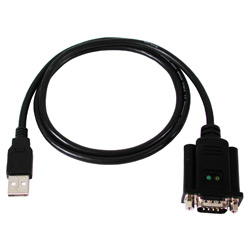Configuring APC SmartUPS with AP9630 Network Cards
|
Alteeve Wiki :: How To :: Configuring APC SmartUPS with AP9630 Network Cards |
This assumes you are on EL8 (CentOS Stream 8 or RHEL 8) with the Alteeve M3 Repo enabled. More specifically, this assumes that you have the screen installed.
Serial Access
By default, the APC AP9630 NMC (Network Management Card) does not have an IP address assigned.
The easiest way to configure an IP address is to log into the UPS's NMC over a serial port. Many servers still come with a built-in 9-pin serial port, but most desktops and laptops do not. If you don't have one, many vendors sell USB to serial adapters. The one we've used quite successfully is the Antaira UTS-1110A, but almost any adapter you can find at your local computer store will work.
| Note: The M3 Anvil! installs screen on all machines. |
We're going to use a program called screen to talk to the PDU over the serial port.
To do this, you need to know what device the PDU's serial cable is plugged into. Some common ones:
| Type | Device path |
|---|---|
| Serial port 1 | /dev/ttyS0 |
| Serial port 2 | /dev/ttyS1 |
| USB-Connected port 1 | /dev/ttyUSB0 |
| USB-Connected port 2 | /dev/ttyUSB1 |
... and so on.
The SMX1500RM2UC includes the new AP9641 network card, which provides a serial connection using a micro-USB port. When connected to a machine (typically a Striker), the /dev/ttyACM0 device is created. Of course, if that device exists already, ttyACM0 will increment to the first free ACMx device number.
Connect:
screen /dev/ttyACM0
First Connection
On the very first connection, you will be prompted to change the password.
User Name : apc
Password : ***
The current password policy requires you to change your password...
Enter current password: ***
Enter new password: ***
Confirm new password: ***
Main Menu
When connecting, enter your password (as set in the initial connection). The default is apc.
User Name : apc
Password : ***
Once authenticated, you will see the main page.
Schneider Electric Network Management Card AOS v1.3.3.1
(c) Copyright 2019 All Rights Reserved Smart-UPS APP v1.3.3.1
-------------------------------------------------------------------------------
Name : apc605BB0 Date : 05/20/2022
Contact : Unknown Time : 23:56:09
Location : Unknown User : Super User
Up Time : 0 Days 6 Hours 43 Minutes Stat : P+ N4? N6+ A+
-------------------------------------------------------------------------------
IPv4 : Enabled IPv6 : Enabled
Ping Response : Enabled
-------------------------------------------------------------------------------
HTTP : Disabled HTTPS : Enabled
FTP : Disabled Telnet : Disabled
SSH/SCP : Enabled SNMPv1 : Disabled
SNMPv3 : Disabled Modbus TCP : Disabled
BACnet/IP : Disabled
-------------------------------------------------------------------------------
Super User : Enabled RADIUS : Disabled
Administrator : Disabled Device User : Disabled
Read-Only User : Disabled Network-Only User : Disabled
Type ? for command listing
Use tcpip command for IP address(-i), subnet(-s), and gateway(-g)
apc>
Set the IP address
In this example, we'll set the IP address 10.201.3.1, which puts it on the Back-Channel Network.
apc>tcpip -i 10.201.3.7 -s 255.255.0.0
E002: Success
Reboot required for change to take effect.
* Reboot required for change to take effect.
apc>reboot -Y
The system will now reboot. See Problems below if it doesn't come back up.
Enable Web and SMTP Access
For use in an Anvil!, we need to enable web and SMTP access.
Enable http (-h) and https access (-s);
apc>web -h enable
E002: Success
Reboot required for change to take effect.
* Reboot required for change to take effect.
apc>web -s enable
E002: Success
Reboot required for change to take effect.
* Reboot required for change to take effect.
Now enable SNMP access, specifically, allow the private and public communities.
apc>snmp -S enable -c1 private -a1 writeplus
E000: Success
* Reboot required for change to take effect.
apc>snmp -S enable -c2 public -a2 writeplus
E000: Success
* Reboot required for change to take effect.
Reboot to make the changes take effect now.
Problems
Can't Ping After Setting IP
When setting the IP address, and then rebooting, you will find over the serial interface that the UPS will get stuck at;
console interrupted on usbuart(1)
BM>
To fix this, run;
BM> boot
The serial connection will close, and then the IP should be pingable.
Recipe
If you know what you're doing, and you want a quick copy-paste configuration, edit the IP to be what you want and then paste this.
| Note: Make sure you change .x to the IP address you want! |
tcpip -i 10.201.3.x -s 255.255.0.0
web -h enable
web -s enable
snmp -S enable -c1 private -a1 writeplus
snmp -S enable -c2 public -a2 writeplus
reboot -Y
| Any questions, feedback, advice, complaints or meanderings are welcome. | ||||
| Us: Alteeve's Niche! | Support: Mailing List | IRC: #clusterlabs on Libera Chat | ||
| © Alteeve's Niche! Inc. 1997-2023 | Anvil! "Intelligent Availability™" Platform | |||
| legal stuff: All info is provided "As-Is". Do not use anything here unless you are willing and able to take responsibility for your own actions. | ||||
